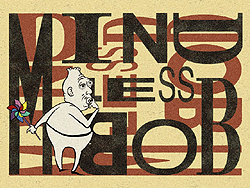|
|
ANIMATION WORLD MAGAZINE - ISSUE 5.8 - NOVEMBER 2000
|
No Boundaries: An Interview With Eric Radomski AA: As a comic artist he's used to drawing the final product himself and seeing it immediately on the page in front of him . . . ER: Exactly, and a lot of the comic art is in the artist's head. The audience is invited in and if you get it, fine, and if you don't, you're gone. We're speaking to a much broader audience, a pretty good chunk of them who've never seen the book and who don't care about the book. They're watching a piece of late night animation and it better tell them a story. They don't care about the cool drawings in the book. They don't care about drawings at all as long as when they come away from it, they're hopefully affected in some way emotionally or just entertained in general. AA: Both with Batman and the HBO shows, the cartoons had more of a cinematic live-action feel to them than traditional fare. Was this something you were consciously aiming for, or did this style evolve out of necessity for the type of stories that you were telling? ER: Spawn was a natural extension or evolution from Batman, to take it not only cinematic but also get into a real stylistic approach. Batman had the traditional three-act setup, but with Spawn, having only six episodes in each season, it was an ongoing and everchanging storyline, with the core being this guy who has a mission which is to find his wife and see if there's any possible way he's going to be able to get back what he lost. It was wonderful, the closest that I've come to really doing my own piece. I could not wait to get to the editing room and try a million different things. I can't tell you how many times I begged and pleaded with Catherine to give me more time in the edit room because I had absolute visions of how some of this stuff was going to play before I even saw it, and it just took a lot of time. Literally, there would be times where within a twenty two-minute episode, I'd have a thousand cuts because a lot of it was half frames, re-uses, flips and flops, effects, and the like. It was all done after the fact. Typically with animation, you send stuff over and what you send you get back. Here I was doing almost special effects in the Avid, because there was no way I could convey those thoughts in my exposure sheets. I had to do it in the edit room so it was very much a live-action mentality of having a cutting room floor except it was all digital. AA: Following along these same lines, when I see some live-action films, I see a level of depth in the characterization and storytelling that I don't see in animation. Do you think an adult animated drama has a place in animation? ER: I think there's definitely a place for an animated adult action-drama. Everything doesn't have to revolve around fairy tales and fantasies. Animation has always, at least for as many years as I've seen, been relegated to marketing and merchandising. I think Blade Runner could exist as an animated film, or a Blade Runner-esque type of film. It's futuristic, they've got vehicles and they've got action characters. If you want to make your merchandising, that's great. It just hasn't been given the opportunity. No one is trusted enough; it always has to be justified with how much money the film will make merchandising-wise. There's no reason that you couldn't do an absolute all-out animated action-drama, and let it compete against any other live-action film. AA: What sort of a role do you see the Internet playing in the future of animation? ER: A lot of the material that's on the Internet now is place holders as far as I'm concerned. It's derivative of television. Right now the best use for the Internet is to sort of incubate ideas. To put up a short, and get a real good sense of whether your idea’s working and whether the audience likes it. Beyond that, delivering on-going content on the Internet is limited so you have to surrender yourself to that, and do something that's pretty much verbal graphics. But embrace the fact that it is a reality and it's not going away. The technology is coming, and artists creating material for the Internet should be prepared to throw away all of the limitations that television places on animation, and just get back to making good product.
The Internet will allow audiences to pick the material they like. People that know the material will pass around the word and eventually creators/producers/directors like myself will be trusted to make stuff that can exist on the Internet, and can be directly marketed to its audience. I believe that will play a big role in moving entertainment, especially animation, forward. AA: How involved have you been with Film Roman's entertainment site Level13.com? ER: I was responsible for the direction and attitude of the entire Level13 project. With Level13, we specifically went for material that was going to be more adult, but that doesn't mean adult in a bottom of the barrel sense which 95% of the stuff on the Internet currently is. Not just a bunch of jokes about excrement, nudity, foul language and racist jokes. A little bit of that is fine for people to exercise their point of view but it's not going to hold up over the long term.
|
||
|
|
